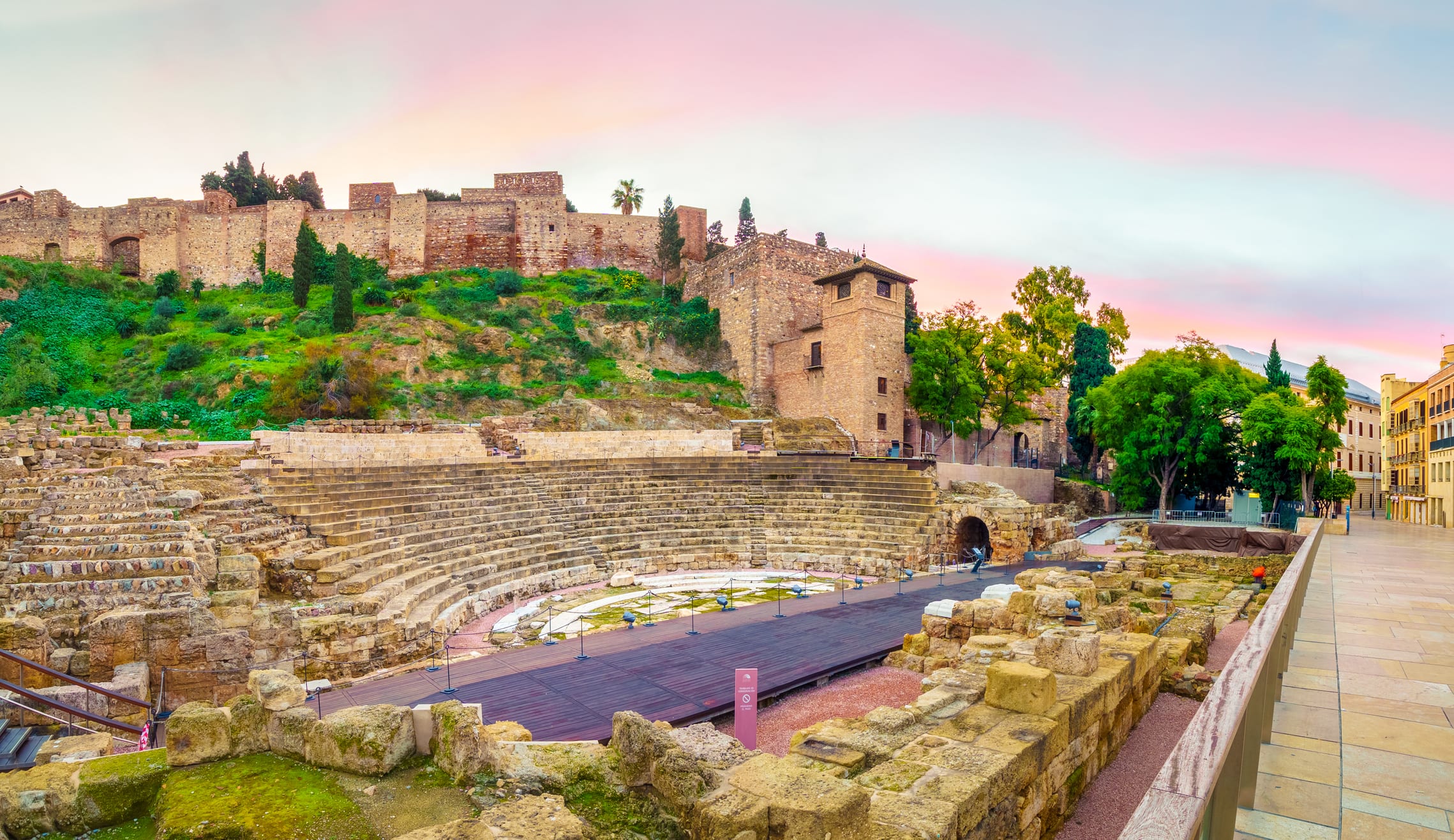
To most visitors, Malaga city and its province is synonymous to beaches. Famous for its sunbed covered beaches, backed by high-rise towns, many don’t realize that Malaga has more to offer than just sun and sand. Those willing to leave the resorts to scratch below the surface will discover a vibrant local culture and lively traditions. Exploration of the towns and countryside will reveal dramatic scenery as well as venerable historical monuments attesting to the Moorish occupation and that of the Romans before them.
Malaga province offers a huge array of activities and experiences, from the cultural to the culinary and from the sedate to the truly exhilarating. Bookmundi recommends nine of the best things to do in Malaga besides hitting to the beach.

Visit the Alcazaba, the Gibralfaro and the Roman Theatre
Step back into Malaga’s past with a visit to three of the city’s most important historical constructions, conveniently located side by side near the city centre. Start with the 14th century Gibralfaro on top of the hill, once considered the most impregnable fortress on the Iberian Peninsula. After completing a circuit of the ramparts, head down to the Alcazaba to admire the opulent Moorish Palace that was begun in the mid-11th century. Finally, finish with an exploration of the remains of the Roman Theatre.
Good to know: A combination ticket granting entry to the Alcazaba and the Gibralfaro is available for €3.55, making it simple to visit the two on the same day. Entry to both is free on Sundays after 2pm and the Roman Theatre is free every day.

Eat espetos in a chiringuito
Take a walk along the seafront of any of the towns on Malaga’s coastline during the months of summer, and you will doubtlessly catch the unmistakable scent of barbecued fish wafting up. This irresistible aroma comes from espetos, freshly-caught fish, usually sardines, cooked in the typical Malagueño style — grilled on a skewer over glowing coals in the sand. A simple and rustic dish, espetos is seasoned only with salt and olive oil, but the rows of crispy fish browning over the flames are as delicious as they look. Sampling them is one of the quintessential culinary experiences on the Costa del Sol.
Good to know: According to a local saying, the best time to eat them is during the months with no ‘R’, meaning from May to August.
Peruse the Museo Picasso Málaga
Pablo Picasso, widely regarded as one of the most influential artists of the 20th century, was born in Malaga, where he spent the first decade of his long life. While the museum in the city of his birth is not considered to house the most significant examples of his work — the collections in Barcelona and Paris are more important — the Picasso museum in Malaga displays a fascinating collection of some of his less famous pieces. Highly recommended for all lovers of art!
Good to know: The permanent collection consists of 233 of Picasso’s artworks. The museum is not large enough to display them all so the collection is constantly rotated. This means you are never guaranteed to see any one piece – and if you visit again, you will probably discover works you had not seen before.
Watch a Málaga CF football match
Football fans shouldn’t pass up on the chance to pay a visit to the Rosaleda Stadium, the 70-year old home of the local team, Málaga CF. An informative tour of the stadium is available, including a visit to the club museum where you can imbibe the history of the club. However, much more exciting is to obtain a matchday ticket to experience the atmosphere and passion of the Spanish top flight at first hand.
Good to know: Unfortunately, the 2017-18 season has not gone well for Málaga. At the time of writing, they are rooted firmly to the bottom of the table and look certain to be relegated. If you don’t manage to see them before the end of this season, next year, you will probably be watching them play in the less glamorous Segunda División.
Scuba diving on the Costa del Sol
Most of the major tourist towns along Malaga’s coastline feature at least a couple of dive schools offering one-day ‘Discover Scuba Diving’ excursions. ‘Open Water’ courses are also available for beginners hoping to become qualified divers. For anyone curious about the wonders of the world beneath the waves, the Costa del Sol is an ideal location to become acquainted with this captivating activity.
Good to know: Schools also offer ‘fun dives’ for those who already have their certification. The coastline offers a broad range of dive sites including several wrecks and even the possibility to dive over a submerged Roman ruin (this site technically belongs to Cadiz but operators in western Malaga province also organise trips there).

Take a trip to Antequera Dolmens Site
Around 55km north of Malaga city, just outside the town of Antequera, lies a group of three megalithic dolmens — ancient burial mounds — some of the most significant prehistoric remains in the country. Dating to the Neolithic or early Bronze Age around 4500 years ago, they are in astonishingly good condition considering their great age. One of them, the Menga Dolmen, is considered the largest such structure in Europe; the biggest stone weighs almost four times as much as the heaviest stone from Stonehenge in England. The area was recognised as a UNESCO World Heritage Site in 2016.
Good to know: The town of Antequera itself is also worth a visit and includes some fine churches as well as an old bullring with an interesting museum filled with bullfighting memorabilia.

Hiking El Caminito del Rey
Malaga province is blessed with a multitude of hiking routes for all abilities but one of the most unique — and formerly most notorious — is the Caminito del Rey. Back at the beginning of the 20th century, a precarious walkway was constructed along the cliff-face of El Chorro Gorge, giving workers access to two hydroelectric stations. As the years passed and it fell into disrepair, it became a magnet for thrill-seekers keen to attempt ‘The Most Dangerous Path in the World’. Now it has been rebuilt and walking the almost 8km hike is a much safer prospect — but you will still be treated to some breathtaking scenery from the vertiginous heights above the Guadalhorce River.

Good to know: The area is particularly rich in flora and fauna. Golden eagles, Egyptian vultures and griffon vultures can be seen in the skies above, while on land, mountain goats, foxes, badgers and various species of lizard and snake are all possible.
Zip-lining
For those who want to combine the rugged beauty of Andalusia’s mountains with a serious hit of adrenaline, the province’s many zip-lines will likely exert an inexorable pull. The Pueblo Blanco of Comares, an hour or so’s drive north-east of Malaga city, is home to the longest zip-line in the country; at 436m in length and more than 100m high, it takes over one hair-raising minute to race from one end to the other. Also, of note is the recently-opened line in Casares — this time ‘only’ 300m long but affording some spectacular views of this impossibly picturesque town.
Good to know: The zip-line in Casares offers a significant reduction for those who can prove they live in the town. For everyone else, the price is around €12.
Parque Natural El Torcal
If you are looking for somewhere to escape the heat and bustle of Malaga city or the crowds of the Costa resorts, head inland to the Parque Natural El Torcal. Situated near the Antequera Dolmen Site, this intriguing park will allow you to stretch your legs on the several rewarding trails and breathe some clean air against a backdrop of some truly bizarre natural limestone formations.
Good to know: The best time to visit is spring and autumn when the weather is cooler, and walks are pleasant.
For adventure seekers, nature lovers, foodies, sports fans and history buffs alike, Malaga has something to satisfy all taste buds. Whatever the season, if you’re in the area, make sure you take some time to explore. If you are unsure where to get started, it is still a good idea to book a guided tour with a trusted tour operator. There is no reason to stick with the mundane in Malaga when it has so much to offer.








